Some things on boats are just disgusting. I have written about the Joker Valve – an essential piece of the sanitary plumbing which must be replaced periodically. But if you think the Joker Valve is disgusting – at least the old one gets thrown away (hopefully sealed in a plastic bag).
But what about the Outlet Hose? This is the bit that connects the Joker Valve to the outside world – which means that everything that passes through the one, also has to pass through the other.
However, a new Outlet Hose is a lot more expensive than a new Joker Valve. Moreover, it doesn’t wear out, so you can’t justify replacing it. Instead, it has to be cleaned.
Let me explain why (you’re going to enjoy this): The combination of human waste and salt water – as passes through the marine toilet – causes a built up of calcified “material” on the inside of the outlet hose. This is rather like domestic pipes getting furred-up or arteries being choked with cholesterol.
Domestic pipes get replaced. Clogged arteries involve surgical procedures which don’t bear thinking about.
Actually, clearing the deposit in an Outlet Hose doesn’t bear thinking about either. Here’s how you do it.
Remove the hose, take it ashore, find a nice open space with a good hard surface and swing the hose three time around your head before whacking it on the hard surface.
I should add that this is tremendously satisfying. It clears the hose in no time at all. However, the cleared “material” does come flying out of the end of the hose and shoots off in all directions. Fortunately, most passers-by have no idea just what that material is.
I used to think that the contents of the Outlet Hose and clearing them out was about the most disgusting aspect of boat-ownership.
But no, I have found something even more appalling.
Here’s what happens: The galley sink drains into a “grey water tank”. Grey water is that type of boat effluent which is one up from “black water” (I’ll let you use your imagination on that one).
Actually “grey water” sounds quite attractive – like something to do with interior décor and water features.
It’s not: Do you have a kitchen drain at home that sometimes gets blocked with grains of rice and slivers of onion and coffee grounds? How does that smell once you’ve neglected it for a few weeks.
Now imagine all of that in a plastic tank in the bilges. It should be emptied by a “gulper” pump – that is, one which is designed to cope with rice and onion and coffee grounds. What do you suppose happens if the gulper pump gets switched off accidentally. The Law of Gravity will still cause the sink to drain all that “grey water” into the tank and if it doesn’t get pumped out, it will overflow – escaping into the open bilges.
And since the bilges are down there somewhere (out of sight and out of mind), you won’t know anything has gone wrong until you smell it.
This is when you take off the top of the engine casing and shine a torch down through the pipes and wires into the bottom of the boat.
For a moment or two, I couldn’t understand why the usual puddle of seawater was orange. The last time I saw orange seawater was in Bilbao in the 1970s – before anyone got excited about pollution. But, when you think about it, I do use a lot of paprika. Paprika turns the washing-up water a brilliant orange, doesn’t it?
So the bilges – indeed, every part of the boat underfoot – is now coated with a sticky deposit of orange goo which smells, unmistakably, of drains.
I don’t even want to think about what I’m supposed to do about it.



John, may I suggest about 20ml of Dettol Disinfectant. Works a treat in my caravan!
Hi John, a fellow OCC member here. Very much enjoying your and your latest has brought memories flooding back of running a flotilla of Mirage 28″s in Greece in the 70’s. The preseason fitouts to get the boats ready for the summer required the overhaul of about 30 Lavac toilets. Needless to say this wasn’t the most enjoyable part of being a flotilla skipper but strangely enough beating the crud out of the inlet hoses in just the manner you describe was in some degree therapeutic! At least by that stage you were back out in the fresh air after being heads down in the heads changing the joker valve and cleaning out the unmentionable stuff that had been left at the end of the previous season!
Hoping we meet up somewhere along the way as I am hoping to be cruising Scottish waters and beyond in 2021.
Keep the posts coming!
Cheers,
Bluey Hellier.
Let me tell you a little story about outlet hoses. I have a 1998 Nauticat 331 which we have owned from new and have over the years changed the joker valve when it no longer stops water feeding back into the toilet bowl. One summer we have my two grandsons on board and they have been taught to always use lots of toilet paper at home. We’re moored in the Beaulieu river and the grandchildren use the toilet but it want pump away. My daughter tries then so do I but can’t pump anything, it is solid. I change the joker valve, no difference but I can see the outlet pipe is jammed full of paper. Luckily we have a second toilet in the aft cabin as I know this is a boat yard job. The yard took 2 hours to unthread the outlet pipe which went a tortuous route through bulkheads to the seacock. When examined it was so badly silted up only half an inch core was left in the centre. A new pipe was threaded and all now works perfectly. An expensive lunch time stop but the old pipe had been in service for fifteen years so I guess value for money it was just about OK.
Thanks for that John – I was just about to have lunch…..
Is the grey water tank a Rival feature? Not come across it before!
Not standard but a good idea because if the sink goes to a seacock it won’t empty on starboard tack. On Largo, I used to force the last of the washing up water away with a plunger. Because the tank is so much lower, it always drains. It also takes the water from the shower tray and the anchor locker so (theoretically) you should have dry bilges. In practice…
‘I don’t even want to think about what I’m supposed to do about it….’
If ever there was an excuse for acquiring a new boat, this is it!
Swinging the heads outlet hose about, flexing it and whacking it on something is exactly the same way I clear mine. That “stuff” that builds up is hard and crystalline and brittle. It breaks easily, and if dry, just tumbles out the pipe. Somewhere.